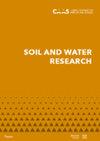侵蚀的南部黑钙土(俄罗斯跨乌拉尔草原)的生物物理化学性质,重点是腐殖酸的13C NMR光谱
IF 1.7
4区 农林科学
Q4 SOIL SCIENCE
引用次数: 2
摘要
研究了俄罗斯巴什科尔托斯坦共和国跨乌拉尔草原区南部黑钙土(chernozem Haplic Endosalic)和侵蚀沉积物的形态、水理化性质、基础呼吸作用。表层土壤层与沉积物的显著不同之处在于其具有更好的结构和水-骨料稳定性。与斜坡土壤相比,由于侵蚀,沉积物的粒度分布包含更多的淤泥和粘土成分。这表明土壤的碳饱和度有很大的潜力,但受到退化的限制。斜坡土壤为微盐渍土,盐渍类型为硫酸盐,含碳氢化合物。СО2排放量大,有机碳和碱性水解氮含量低;且明显低于侵蚀沉积物,但交换性阳离子和水溶性盐的含量较高。用13C核磁共振波谱测定了从土壤和侵蚀沉积物中提取的腐殖酸(HA)的结构组成。脂肪族结构片段占主导地位(65%),在表层HA中的C,H-烷基区域具有最大信号水平。在侵蚀沉积物的HA中,芳香结构碎片的比例较高(高达59%),这与水解和缩合过程有关。在斜坡土壤的HA中,主要形成C、H烷基、含氧基团,包括羧基。土壤和沉积物HA的结构碎片和官能团组成的差异是由于有机质在土壤侵蚀过程发展条件下的稳定性不同。本文章由计算机程序翻译,如有差异,请以英文原文为准。
Biophysicochemical properties of the eroded southern chernozem (Trans-Ural Steppe, Russia) with emphasis on the 13C NMR spectroscopy of humic acids
The morphological, water-physical and chemical properties, basal respiration of the southern chernozem (Chernozem Haplic Endosalic) and erosional sediment in the Trans-Ural steppe zone (Republic of Bashkortostan, Russia) were studied. The surface soil horizon significantly differs from the sediment by the better structure and water aggregate stability. The particle size distribution of the sediments, due to erosion, contains more silt and clay fractions compared to the slope soil. It indicates a great potential for the carbon saturation of the soil which is limited by degradation. The slope soil is slightly saline, the type of the salinisation is sulfate with the participation of hydrocarbonates. The СО2 emissions, the organic carbon and alkaline-hydrolysable nitrogen content is low; and significantly lower than in the erosional sediment, but the content of exchangeable cations and water-soluble salts is higher. The structural composition of the humic acid (HA) extracted from the soil and erosional sediments was determined by 13C NMR spectroscopy. Aliphatic structural fragments predominate (65%) with a maximum signal level in the area of C, H-alkyls in the HA of the surface horizon. In the HA of the erosional sediment, the proportion of aromatic structural fragments is higher (up to 59%), which is associated with the processes of hydrolysis and condensation. In the HA of the slope soil, the formation of predominantly C, H-alkyls, oxygen-containing groups, including carboxyl ones, takes place. Differences in the composition of the structural fragments and functional groups of the soil and sediment HA are due to the different stability of the organic matter under conditions of the development of the soil erosion processes.
求助全文
通过发布文献求助,成功后即可免费获取论文全文。
去求助
来源期刊

Soil and Water Research
Water resources, Soil Science, Agriculture-WATER RESOURCES
CiteScore
4.60
自引率
0.00%
发文量
26
审稿时长
>12 weeks
期刊介绍:
An international peer-reviewed journal published under the auspices of the Czech Academy of Agricultural Sciences and financed by the Ministry of Agriculture of the Czech Republic. Published since 2006.
Thematic: original papers, short communications and critical reviews from all fields of science and engineering related to soil and water and their interactions in natural and man-modified landscapes, with a particular focus on agricultural land use. The fields encompassed include, but are not limited to, the basic and applied soil science, soil hydrology, irrigation and drainage of lands, hydrology, management and revitalisation of small water streams and small water reservoirs, including fishponds, soil erosion research and control, drought and flood control, wetland restoration and protection, surface and ground water protection in therms of their quantity and quality.
 求助内容:
求助内容: 应助结果提醒方式:
应助结果提醒方式:


